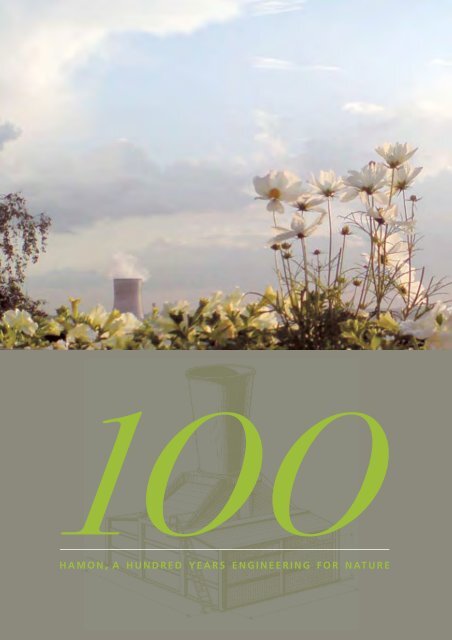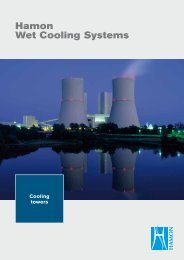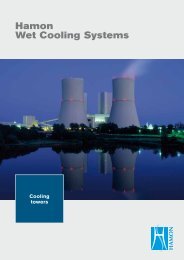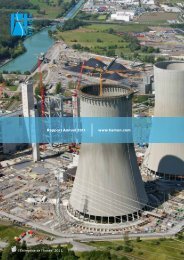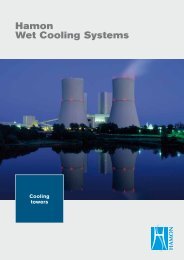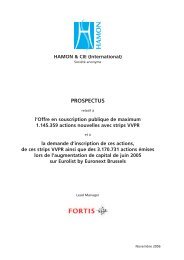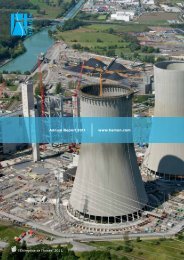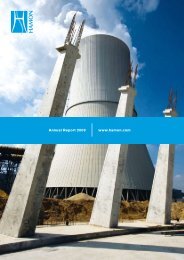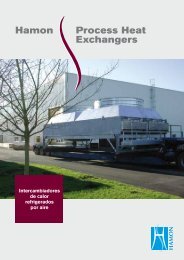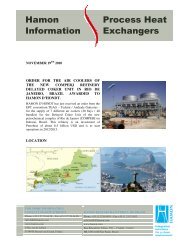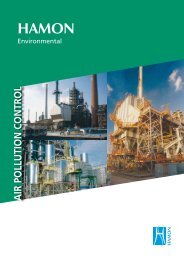Hamon, a hundred years engineering for nature (PDF 2Mo)
Hamon, a hundred years engineering for nature (PDF 2Mo)
Hamon, a hundred years engineering for nature (PDF 2Mo)
You also want an ePaper? Increase the reach of your titles
YUMPU automatically turns print PDFs into web optimized ePapers that Google loves.
h a m o n, a <strong>hundred</strong> <strong>years</strong> <strong>engineering</strong> <strong>for</strong> nat u r e
Dear reader,<br />
It has been and is still an immense honor and privilege to be the<br />
President of <strong>Hamon</strong>, and this <strong>for</strong> the last 20 <strong>years</strong>.<br />
In the middle of the 1980s, I found a company that was well established and<br />
enjoyed a good reputation worldwide. Even though we were quite focused on<br />
just one market, the basics were already there: wonderful people and a group of<br />
technicians and engineers who were already experienced in delivering the best<br />
solutions to their clients anywhere in the world. We were a group with passion<br />
so big we could move mountains, and sometimes we did.<br />
With that team, we were able to build a diversified group that is now present<br />
all over Europe, North America and South America, and in parts of Africa and<br />
Asia. Of course there have been difficult times, but we have overcome them<br />
together, and have given the <strong>Hamon</strong> Group both profits and a future in the<br />
service of the environment.<br />
The people who are with me today have, I believe, that same passion that we<br />
had 20 <strong>years</strong> ago, “the <strong>Hamon</strong> bug”, I hear them say. Well, I dearly hope that<br />
this continues <strong>for</strong> many more generations to come.<br />
Francis Lambilliotte, CEO, <strong>Hamon</strong> & Co
The Board of Directors of the <strong>Hamon</strong> Group in 1985: in the center, Mrs. Louisette <strong>Hamon</strong>, on the left Mr. Francis Lambilliotte and on the right Mr. Jacques Lambilliotte.<br />
Standing, from left to right, Mr. Michel Vauzanges, Mr. Georges Degavre, Mr. André Brosius, Mr. André Pâquet, and Mr. Michel Derclaye
Achille & Fernand <strong>Hamon</strong><br />
“Achille <strong>Hamon</strong>, my great grand-uncle, and his brother, Fernand, my<br />
great grandfather, were both from Brittany in France. Both were engineers<br />
and they owned a company that worked and assembled projects in wood.<br />
In 1904, Achille created a company in France, and in 1906, Fernand<br />
did the same in Belgium. Both companies produced the cooling towers<br />
required <strong>for</strong> the new industrial processes.<br />
As it turned out, this was perfect timing as the industrial revolution<br />
needed ways to treat the water that came from the mines, the steel works,<br />
and the new electric power stations.” Francis Lambilliotte, CEO, <strong>Hamon</strong> & Co<br />
Creation of <strong>Hamon</strong> France,<br />
and then <strong>Hamon</strong> Belgium<br />
The <strong>Hamon</strong><br />
Brothers, inventors<br />
in a century<br />
of inventors<br />
1889<br />
1904 & 1906<br />
1914<br />
Participation in the construction<br />
of the Eiffel Tower<br />
“A passion <strong>for</strong> towers must be in the family genes<br />
because I’ve always heard that members of<br />
the <strong>Hamon</strong> family participated in the construction<br />
of the Eiffel Tower.” Francis Lambilliotte<br />
Contribution to the war ef<strong>for</strong>t<br />
“Business was on stand-by during the war. Fernand came<br />
back to Paris to be with his brother, and they decided to do<br />
what they could to help. At that time, the cooling towers<br />
were still being built in wood, and they had lots of reserves<br />
available in the workshop as well as the skills necessary. They<br />
put their expertise to work <strong>for</strong> the French army and built both<br />
the structure and the huts <strong>for</strong> trenches.” Francis Lambilliotte<br />
“They also built a series of pre-fabricated homes <strong>for</strong><br />
families that had lost theirs. These were named ‘The houses<br />
of King Albert’. And while they were meant to be temporary,<br />
they lasted until the end of the Second World War!”<br />
Georges Degavre, ex-CFO, <strong>Hamon</strong>
1927 1935<br />
Participation at the World Fair<br />
in Brussels<br />
Creation of Sobelco<br />
Maurice, the son of Fernand and there<strong>for</strong>e my grandfather,<br />
did his studies in Paris and then later settled in Belgium.<br />
He was young, independent and wanted to create a<br />
business <strong>for</strong> himself, without the help of the family.<br />
He started Sobelco, a company focused on the development<br />
and production of condensers and cooling towers <strong>for</strong><br />
electric power plants.” Francis Lambilliotte<br />
“Sobelco, like <strong>Hamon</strong> be<strong>for</strong>e it, was created with perfect<br />
timing. Condensers were essential <strong>for</strong> the electric power<br />
stations, more and more of which were being built to<br />
meet the energy needs of growing industry.” Georges Degavre<br />
Maurice <strong>Hamon</strong>, engineer,<br />
creator, explorer.
1958<br />
Participation at the World Fair<br />
in Brussels<br />
The United States, the first step in the<br />
internationalization of the cooling tower business<br />
“When both Fernand and Achille died, and my grandfather found himself<br />
at the head of <strong>Hamon</strong> France and Belgium, one of his first big decisions<br />
was to try and get new business from the US market. After a relatively slow<br />
start, a first order was received and others soon followed. This gave rise to a<br />
problem that nobody had <strong>for</strong>eseen, namely that the company was too small<br />
<strong>for</strong> its success. The ideal situation was to build over there, but that meant<br />
bank guarantees that they didn’t have. Maurice chose <strong>for</strong> the only option<br />
possible at the time: he gave a license to an American partner, the company<br />
Research-Cottrell. A license and a company that, as it turned out,<br />
I would buy 30 and 40 <strong>years</strong> later respectively!” Francis Lambilliotte<br />
“The company Cottrell, originally established at the same time as <strong>Hamon</strong>, was<br />
a world leader in the provision of dedusting systems. Most notably it developed<br />
electrostatic precipitators, using a technology invented by Frederick Gardner<br />
Cottrell in 1909.” Philippe Delvaux, Managing Director, <strong>Hamon</strong> Research-Cottrell<br />
“The American adventure turns sour, and quickly becomes a liability. For 5 <strong>years</strong><br />
there was not a single order. In Brussels, those close to the “boss” wanted only<br />
one thing: to stop the investment! In 1963, Maurice brings all the directors into<br />
his office, and they discuss the US venture. He asks the assembled group <strong>for</strong> their<br />
opinion. One of the colleagues takes the floor and speaks on behalf of the others,<br />
‘We’re all in agreement, it’s not working and we’re losing too much money…’.<br />
The conclusion from Maurice, ‘Thank you <strong>for</strong> your advice, but we’re continuing.’<br />
He was as stubborn as a Breton!” Jean Gilbert, Corporate Vice President, <strong>Hamon</strong> & Co<br />
“At the end of the 1950s, <strong>Hamon</strong> enters the Spanish market. This was based on<br />
an agreement between Maurice <strong>Hamon</strong> and my father, founder of the company<br />
Esindus. 50 <strong>years</strong> later, Esindus is the leader in cooling towers. Our relationship<br />
with <strong>Hamon</strong> is both healthy and friendly, so much so that it led to Esindus<br />
taking a stake in <strong>Hamon</strong>.” Martin Gonzalez del Valle, President, Esindus<br />
Visit by Baudouin, King of the Belgians at that time
1964 1968<br />
First order from the US brought<br />
by Research-Cottrell<br />
“Between 1960 and 1983, <strong>Hamon</strong> Research-Cottrell built<br />
66 cooling towers out of a total of 110 across the country, giving it<br />
more than 60% of the American market.” Francis Lambilliotte<br />
Fusion of the companies <strong>Hamon</strong> and Sobelco,<br />
under the name <strong>Hamon</strong> Sobelco<br />
“Maurice was right across the line. First by introducing a concept<br />
that was up until that point unknown, namely cooling towers that<br />
used natural draft, and secondly by believing in his product.”<br />
George Degavre<br />
Sights set <strong>for</strong><br />
the new world
1970<br />
1973<br />
Contracts in Germany,<br />
South Africa and Australia<br />
“After the USA, Maurice turned his sights towards the German market,<br />
and despite facing an important national competitor, he wins his first piece<br />
of business. This victory was due to the fact that on the technological side<br />
<strong>Hamon</strong> was some distance ahead of the competition, this thanks to the <strong>years</strong><br />
of experience gained with their main French client, the EDF.” Jean Gilbert<br />
“The industrialization of South Africa also brings major orders <strong>for</strong> cooling<br />
towers, condensers and heaters: 12 x 600 MW. An order that represented<br />
60 million dollars at the time.” Francis Lambilliotte<br />
Death of Maurice <strong>Hamon</strong>. The management<br />
of the company is handled on an interim basis<br />
by his widow, Louisette <strong>Hamon</strong><br />
“The day she arrived in the company, she sat at the desk of her<br />
late husband. Her first words: ‘what problems need to be solved<br />
today, and who is responsible? We’ll ask that question every day<br />
from now on.’ And she did, until Francis took over in 1985.”<br />
Georges Degavre<br />
The history of<br />
a company,<br />
or the life of a family
Francis Lambilliotte receives from Prince Albert, the prize <strong>for</strong> best Belgian exporter<br />
(Prince Albert is the current King of the Belgians<br />
1974<br />
1980<br />
1985<br />
Creation of <strong>Hamon</strong> Kühltürme<br />
und Apparatebau GmbH Bochum<br />
“The protection of the environment has<br />
become one of the major challenges <strong>for</strong> the<br />
modern industrial world. We began working<br />
in this direction by complementing our product<br />
offer with services, in particular the renovation<br />
and control of existing towers.”<br />
Rodica Exner, President BU-Cooling-Systems <strong>Hamon</strong><br />
Arrival of Francis Lambilliotte<br />
and progressive taking over of<br />
the reins at the top<br />
“During 5 <strong>years</strong>, I learned on the job and<br />
only took over the management of <strong>Hamon</strong><br />
in 1985. Fortunately I had the help and<br />
advice of my father, Jacques Lambilliotte,<br />
who became Chairman of the board.”<br />
Francis Lambiliotte<br />
Purchase of the original license<br />
sold to Research-Cottrell<br />
“I believed that the work being done at the<br />
time by Research-Cottrell in the United States<br />
was insufficient. I believed it was important<br />
to recover the worldwide rights to our<br />
technology. So I bought back the license that<br />
my grandfather had sold in the late 1950s.”<br />
Francis Lambiliotte
1985<br />
1987<br />
The beginning of diversification:<br />
the purchase of Spiro-Gills and the Company,<br />
Ateliers François d’Hondt<br />
“I had the feeling that our company was too mono product focused, as<br />
at that time we were just producing wet cooling towers. So I decided<br />
to diversify our activities. I made sure that we chose companies and<br />
products that were complementary to our field of expertise, namely in<br />
the thermodynamics and heat exchange business.” Francis Lambilliotte<br />
“So <strong>Hamon</strong> bought Spiro-Gills, a French company, and the Ateliers<br />
François d’Hondt, in Belgium. Both were specialists in heat exchange,<br />
and air coolers <strong>for</strong> the petro-chemical industry. Both technologies<br />
demand an excellent understanding of dimensioning. In short, this<br />
technique consists of working out the exchange surface area necessary to<br />
cool a gas, water or any other liquid between point A and point B.”<br />
René Robert, General Manager, <strong>Hamon</strong> d’Hondt<br />
Purchase of Air Industrie Thermique<br />
and a partnership in Korea<br />
“As the price of oil increased, it soon became evident<br />
that it would be useful to have at our disposal a heat<br />
recovery system, thus allowing us to recuperate energy<br />
in the gas and steam to heat water and other fluids.<br />
That’s when we decided to buy Air Industrie Thermique<br />
as well as a number of other smaller companies, who<br />
together, gave us a good position on the French market<br />
<strong>for</strong> everything that had to do with thermal exchange.”<br />
Francis Lambilliotte<br />
“In all the countries where we go, we always try to<br />
have a local partner, someone from the country who<br />
knows the language and the culture. Together we make<br />
the ideal team towards prospective clients: our partner<br />
brings their understanding of the local way of working,<br />
while we, we bring that extra something that they were<br />
looking <strong>for</strong> in the first place, namely an extraordinary<br />
made to order technical solution.<br />
The ‘secret’ of our international success is just that,<br />
<strong>Hamon</strong> first aims to understand the country and the<br />
people we’re going to deal with. We really don’t propose<br />
pre-cooked solutions, instead we listen and work out the<br />
best options <strong>for</strong> them. In this manner we created <strong>Hamon</strong><br />
Korea in partnership with Ken Chun.” Jean Gilbert<br />
10
The importance<br />
of the respect<br />
of cultures<br />
1992 1995<br />
1997<br />
Sale of Sobelco, and the<br />
purchase of several smaller<br />
companies as well as the start<br />
of dry cooling systems<br />
“Following several mergers in the turbine<br />
business, the number of clients <strong>for</strong> Sobelco<br />
was getting smaller and smaller, so did a deal<br />
with the Alstom Group. We sold them Sobelco<br />
and bought from them the company Scam,<br />
who like us was focused on cooling. This move<br />
consolidated our position as industry leader.”<br />
Jean Gilbert<br />
“At the same time, I wanted us to diversify even<br />
more, so we entered into a joint venture with<br />
ABB-Lummus, a specialist in dry cooling.”<br />
Francis Lambilliotte<br />
New ventures in China,<br />
Malaysia, Japan and Indonesia<br />
“The reputation of <strong>Hamon</strong> helps us in<br />
our search <strong>for</strong> international business. Our<br />
name is well known and associated with a<br />
specific technological know-how. On top of<br />
that we have considerable experience in the<br />
management of international projects, both<br />
on the business side of things as well as on<br />
the relational aspects. When we arrive in a<br />
country, while we do know what’s going on,<br />
we never act as arrogant conquerors who<br />
know it all!” Eric Binard, Sales Director<br />
BU-Cooling Systems <strong>Hamon</strong><br />
Quoted on the<br />
stock exchange<br />
“It was an important year and<br />
an exciting one too, in particular<br />
because the operation was such a<br />
success. We received 6 times more<br />
requests <strong>for</strong> shares than we had<br />
on offer. The result meant that<br />
we were able to raise capital of<br />
about 680 million BEF, (roughly<br />
$17 million). Apart from giving us<br />
more means at our disposal, it also<br />
raised our profile considerably.”<br />
Francis Lambilliotte<br />
11
1998<br />
2002<br />
Purchase of a series of companies in the USA:<br />
Research-Cottrell, Custodis<br />
and Thermal Transfer Corporation<br />
“Between the moment when Francis’ grandfather sold the<br />
<strong>Hamon</strong> license to Research-Cottrell and when Francis bought<br />
the 3 companies, much water had flowed under the bridge.<br />
Among other things, we’ve added air pollution control and<br />
heat recovery to our portfolio, as well as the building of<br />
industrial chimneys.” Philippe Delvaux<br />
Slow down of our business<br />
“We went through a difficult period, and this<br />
essentially due to 3 factors: our very rapid<br />
growth, the virtual stop of new power plant<br />
builds in the USA following the Enron affair,<br />
and the liberalization of the energy market<br />
in Europe. All this at a time when we needed<br />
the orders to pay <strong>for</strong> our new acquisitions.”<br />
Francis Lambilliotte<br />
“Just like <strong>Hamon</strong>, Research-Cottrell also has a century of<br />
tradition behind it. It was one of the leading innovators in<br />
its industry. And as with <strong>Hamon</strong>, it had its fair share of<br />
highs and lows, but that didn’t stop it from being a major<br />
success story. That’s rare <strong>for</strong> a company, and I think much<br />
credit should go to those people who were part of it during<br />
those times.” Ollie Acheson, CFO <strong>Hamon</strong> Corporation USA<br />
“Custodis, founded in 1898, has been part of Research-Cottrell<br />
since 1968. The complementarity of both companies’ respective<br />
activities, as well as their excellent reputation as innovators in<br />
both chimneys and silos, made the purchase a logical one.<br />
To give just one example of our pioneering spirit, when the<br />
cooling towers arrived in the USA, it was us who built the<br />
hyperbolic shells!” John Boone, President, <strong>Hamon</strong> Custodis Inc.<br />
“These different acquisitions led to the creation of the 4 current<br />
main activities of business. The cooling towers still represent<br />
a 1/3rd of our activity, alongside the heat exchangers, and<br />
air pollution control as well as chimneys. Together, under the<br />
name <strong>Hamon</strong>, there is quite some knowledge and experience,<br />
as each of the 3 companies - d’Hondt, Research-Cottrell and<br />
Custodis - have more than 100 <strong>years</strong> of history.” Jean Gilbert<br />
12
On the way<br />
to being both<br />
a larger and<br />
stronger group<br />
2003<br />
2007<br />
A recovery with the help of an audacious plan<br />
“With the support of our new finance director, Bernard Van Diest, I decided<br />
that we had to do the right thing, and do it properly. We opted <strong>for</strong> a series of<br />
measures: concentrate on our core businesses; reduce overheads by 25%; and sell<br />
those businesses that were less profitable. We also decided to sell the dry cooling<br />
business (co-directed at the time by Aart Nobel), and <strong>for</strong> this we received a good<br />
price. Finally we also chose <strong>for</strong> a new business model <strong>for</strong> the American market.<br />
Our strategy consisted of out-sourcing to countries where production costs were<br />
lower. Thanks to these steps, we were able to operate on a sounder basis, starting<br />
first in the USA with Aart as the managing director.” Francis Lambilliotte<br />
“In the United States, the tighter legislation as it relates to the protection of<br />
the environment gave us the perfect opportunity to increase our order book.<br />
Both internally and externally with partners, we intensified our ef<strong>for</strong>ts in<br />
research and development so as to provide better solutions <strong>for</strong> our clients.<br />
This helped enormously in raising our profile, and our commercial success.<br />
This approach also <strong>for</strong>ced us to develop a portfolio of products that were<br />
needed and wanted by the market.” Aart Nobel, CEO, <strong>Hamon</strong> Corporation USA<br />
“In 2005, it was the Division Research-Cottrell that maintained the financial<br />
health of the group. This seemed fair, and part of the swings and roundabouts<br />
that is business. When Francis bought us, it was us that were going<br />
through difficult times. I believe in fact, that had we not been bought at that<br />
time we might not exist at all now!” Philippe Delvaux<br />
Business is booming<br />
“At Research-Cottrell, we are com<strong>for</strong>table with<br />
the way we are currently ahead of our previsions.<br />
We’re also intensifying contacts with our key<br />
targets: the electric power plants, the petrochemical<br />
and steel sectors, the cement companies<br />
and the glass industry, as well as the market <strong>for</strong><br />
waste incineration. In fact, we’ve just signed an<br />
agreement in Bulgaria. And while we’re talking<br />
about good things, I’ve just received the results<br />
of a new satisfaction survey. We are to sum it up<br />
briefly, perceived as a company with high added<br />
value, working with experts of the highest caliber,<br />
and we are very customer focused.” Philippe Delvaux<br />
“Our success is also due to the fact that we have<br />
been concentrating on 2 high potential sectors:<br />
the electricity producers that represent 50% of<br />
our business, and the oil producers, who make<br />
up another 30%. The demand in both sectors is<br />
growing. In the developed countries, the old power<br />
plants are being replaced with newer and cleaner<br />
installations, while in the emerging markets, we<br />
are building new plants.” Francis Lambilliotte<br />
“From that year on, the situation improved considerably. Helped by the<br />
Walloon region, we increased the capital of the business. This brought fresh<br />
funds to the company, and an injection of cash that allowed us to keep the<br />
business growing. We continued with this financial approach, and in<br />
November 2006, we made a second call <strong>for</strong> capital. This brought an extra<br />
20 million Euro. During that same year, our share price increased by 352%,<br />
which put us at the top of the Euronext ranking, and <strong>Hamon</strong> had a profit of<br />
some 13 million Euro. We had succeeded our return to <strong>for</strong>m.” Francis Lambilliotte<br />
13
Do better what we’ve been<br />
doing <strong>for</strong> the last 100 <strong>years</strong>:<br />
help our clients produce more<br />
cleanly and produce more<br />
Jean Gilbert,<br />
Corporate Vice President, <strong>Hamon</strong> & Co<br />
“We are continuing to invest in applied<br />
research, and this in partnership with<br />
both our clients as well as with American<br />
and European universities. With our<br />
clients, the questions are more related<br />
to cooling systems and heat exchangers,<br />
while with the universities, we are<br />
concentrating more on problems related<br />
to air pollution control.”<br />
Aart Nobel,<br />
CEO, <strong>Hamon</strong> Corporation USA<br />
“We’ve also made a technological partnership<br />
with industrial partners like Exxon, in this way<br />
we’re able to ally their specialist knowledge with<br />
the know-how of our civil engineers. Moreover,<br />
we have concentrated on the standardization of<br />
our designs, <strong>engineering</strong> and purchasing,<br />
all of which has helped us deliver more quickly<br />
to market and with the lowest error rate in<br />
the whole industry.”<br />
2007...<br />
Ollie Acheson,<br />
CFO, <strong>Hamon</strong> Corporation USA<br />
“Belgians, Americans, French, Germans and<br />
all the other members of the Group, now enjoy<br />
a position that we’ve not known <strong>for</strong> 30 <strong>years</strong>.<br />
For me, it is clear that this healthy position is<br />
the natural outcome of the pertinence of our<br />
products, of the good strategic decisions taken<br />
in the past, and the ef<strong>for</strong>ts made by each and<br />
every member of our teams today.”<br />
Michel Monjoie<br />
Head, Research & Development<br />
“For me, wet cooling has a great future ahead<br />
of it, because it allows us to directly reduce the<br />
CO 2<br />
emissions from the power plant, much<br />
more so that with dry cooling. On top of that<br />
we’re able to make it happen with recycled<br />
water or even water from the sea.”<br />
Aart Nobel,<br />
CEO, <strong>Hamon</strong> Corporation USA<br />
“In short we have attained a level of stability,<br />
maturity and growing confidence that could not<br />
have been anticipated only a few <strong>years</strong> ago.”<br />
Francis Lambilliotte,<br />
CEO, <strong>Hamon</strong> & Cie<br />
“Our clients are investing more and more to<br />
counteract pollution and we’re helping them produce<br />
more, and produce more cleanly. For example, by<br />
improving the productivity of 10 power plants by<br />
10%, we’re able to close one down. Or in other words<br />
we can produce 10% more power without building<br />
a new one. That’s less greenhouse gases <strong>for</strong> everyone.<br />
I think that <strong>Hamon</strong> will become the partner of an<br />
increasing number of industrial companies who take<br />
the environmental imperative seriously.”<br />
Philippe Delvaux,<br />
Managing Director, <strong>Hamon</strong> Research-Cottrell<br />
“As our activity is completely in phase with ecology,<br />
we have an enormous market in perspective. And<br />
as our products are good and we have a boss who is<br />
prepared to take risks…”<br />
14
h a m o n , a <strong>hundred</strong> <strong>years</strong> <strong>engineering</strong> <strong>for</strong> nat u r e


